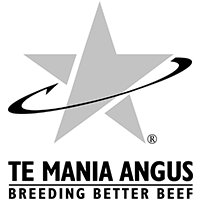Available to applicants enrolled or intending to enrol in Year 1 of the Bachelor of Business (Agriculture) or Bachelor of Business (Agribusiness). The funds will be allocated on the basis of $10,000 in Year 1 of study and $10,000 in the final year of study.
| Closing date | 11 August 2025 (5pm AEST) |
| Interview date | Week beginning 15 September 2025 |
The Te Mania Angus herd is comprised of 1700 stud Angus females and 300 recipient females. The herd is run under commercial conditions, with a focus on sound, highly fertile and docile cattle. Genetic focus is applied to calving ease, growth, carcase quality and structure, while constant research is undertaken to maximise efficiencies. Recent on-farm research has involved monitoring heifer puberty and net feed intake.
Approximately 900 bulls are marketed each year through two bull sales, contracted volume sales and the bull leasing program, Team Te Mania.
Established in 1995, the program Team Te Mania is unique for its kind in the industry and uses Te Mania Angus genetics exclusively across over 40 commercial herds in New South Wales, Victoria and South Australia. Feedback and analysis of data from these herds increase the accuracy and predictability of Te Mania Angus genetics and provides the leverage for those producers to share a highly regarded genetic brand.
Te Mania was founded in 1928 by Edwyn Wilding, father of Mary Gubbins, in the South Island of New Zealand. In 1971 Andrew and Mary Gubbins imported two young sires and 58 females, from Mary’s brother, Frank, creating Te Mania Angus, Australia.
In 1980, the first-ever on-farm embryo transfer program was carried out at Te Mania Angus. It has been used every year since that time. Today, Te Mania Angus is managed by Tom and Lucy Gubbins at Mortlake in Western Victoria and Hamish and Amanda McFarlane at Connewarre near Geelong.
Te Mania Angus genetics have played a pivotal role in the Angus shift to become the most sought-after breed in Australia, at every level of the beef production chain.
Applicants intending to enrol must meet College entry requirements.
- From both local and global perspectives, what do you identify as the major challenges that the Australian cattle industry is likely to encounter in the next five to ten years?
- What are your career goals and aspirations?
